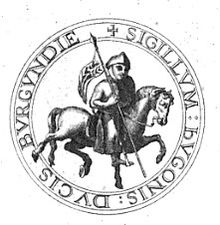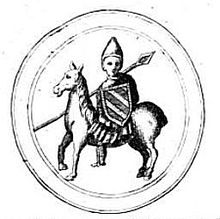Hugh II, Duke of Burgundy
Appearance


Hugh II of Burgundy (1084 – c. 6 February 1143) was duke of Burgundy between 1103 and 1143. Hugh was son of Odo I, Duke of Burgundy.[1] Hugh was selected custos for the monastery of St. Benigne, and this office would be held by his descendants until the end of the twelfth century.[2]
Marriage and issue
He married, in about 1115, Felicia-Matilda of Mayenne, daughter of Gauthier, Count of Mayenne and Adelina de Presles.
They had the following:
- Aigeline of Burgundy (b.1116), married Hugh I, Count of Vaudemont
- Clemence of Burgundy (b.1117), married Geoffrey III of Donzy[1]
- Odo II, Duke of Burgundy, (1118–1162) married Maria of Champagne[1]
- Gauthier, Archbishop of Besançon (1120–1180)
- Hugh le Roux (1121–1171) married Isabel of Chalon[1]
- Robert, Bishop of Autun (1122–1140)[1]
- Henry, Bishop of Autun (1124–1170)[1]
- Raymond, Count of Grignon (1125–1156) married Agnes of Montpensier[1]
- Sibylla of Burgundy (1126–1150), married Roger II of Sicily[3]
- Ducissa (b.1128), married Raymond de Grancy
- Matilda of Burgundy (1130–1159), married William VII of Montpellier[1]
- Aremburge (b.1132),[1] Nun
Ancestry
| Family of Hugh II, Duke of Burgundy | |||||||||||||||||||||||||||||||||||||||||||||||||||||||||||||||||||||||||||||||||||||||||||||||||||||||||||||||||||||||||||||||||||||||||||||||||||||||||||||||||||||||||||||||||||||||||||||||||||||||||||||||||||||||||||||||||||||||||||||||||||||||||||||||||||||||||||||||||||||||||||||||||||||||||||||||||||||||||||||||||||||||||||||||||||||||||||||||||||||||||||||||||||||||||||||||||||||||||||||||||||||||||||||||||||||||||||||||||||||||||||||||||||||||||||||||||||||||||||||||||||||||||||||||||||||||||||||||||||||||||||||||||||||||||||||
|---|---|---|---|---|---|---|---|---|---|---|---|---|---|---|---|---|---|---|---|---|---|---|---|---|---|---|---|---|---|---|---|---|---|---|---|---|---|---|---|---|---|---|---|---|---|---|---|---|---|---|---|---|---|---|---|---|---|---|---|---|---|---|---|---|---|---|---|---|---|---|---|---|---|---|---|---|---|---|---|---|---|---|---|---|---|---|---|---|---|---|---|---|---|---|---|---|---|---|---|---|---|---|---|---|---|---|---|---|---|---|---|---|---|---|---|---|---|---|---|---|---|---|---|---|---|---|---|---|---|---|---|---|---|---|---|---|---|---|---|---|---|---|---|---|---|---|---|---|---|---|---|---|---|---|---|---|---|---|---|---|---|---|---|---|---|---|---|---|---|---|---|---|---|---|---|---|---|---|---|---|---|---|---|---|---|---|---|---|---|---|---|---|---|---|---|---|---|---|---|---|---|---|---|---|---|---|---|---|---|---|---|---|---|---|---|---|---|---|---|---|---|---|---|---|---|---|---|---|---|---|---|---|---|---|---|---|---|---|---|---|---|---|---|---|---|---|---|---|---|---|---|---|---|---|---|---|---|---|---|---|---|---|---|---|---|---|---|---|---|---|---|---|---|---|---|---|---|---|---|---|---|---|---|---|---|---|---|---|---|---|---|---|---|---|---|---|---|---|---|---|---|---|---|---|---|---|---|---|---|---|---|---|---|---|---|---|---|---|---|---|---|---|---|---|---|---|---|---|---|---|---|---|---|---|---|---|---|---|---|---|---|---|---|---|---|---|---|---|---|---|---|---|---|---|---|---|---|---|---|---|---|---|---|---|---|---|---|---|---|---|---|---|---|---|---|---|---|---|---|---|---|---|---|---|---|---|---|---|---|---|---|---|---|---|---|---|---|---|---|---|---|---|---|---|---|---|---|---|---|---|---|---|---|---|---|---|---|---|---|---|---|---|---|---|---|---|---|---|---|---|---|---|---|---|---|---|---|---|---|---|---|---|---|---|---|---|---|---|---|---|---|---|---|---|---|---|---|---|---|---|---|---|---|---|---|---|---|---|---|---|---|---|---|---|---|---|---|---|---|---|---|---|---|---|---|---|---|---|---|---|---|---|---|---|---|---|---|---|---|---|---|---|---|---|---|---|---|---|---|---|---|---|---|---|---|---|---|---|---|---|---|---|---|---|---|---|---|---|---|---|---|---|---|---|---|---|---|---|---|---|---|
| |||||||||||||||||||||||||||||||||||||||||||||||||||||||||||||||||||||||||||||||||||||||||||||||||||||||||||||||||||||||||||||||||||||||||||||||||||||||||||||||||||||||||||||||||||||||||||||||||||||||||||||||||||||||||||||||||||||||||||||||||||||||||||||||||||||||||||||||||||||||||||||||||||||||||||||||||||||||||||||||||||||||||||||||||||||||||||||||||||||||||||||||||||||||||||||||||||||||||||||||||||||||||||||||||||||||||||||||||||||||||||||||||||||||||||||||||||||||||||||||||||||||||||||||||||||||||||||||||||||||||||||||||||||||||||||
Notes
- ^ a b c d e f g h i Constance Brittain Bouchard, Sword, Miter, and Cloister: Nobility and the Church in Burgundy, 980–1198, (Cornell University Press, 1987), 256.
- ^ Constance Brittain Bouchard, Sword, Miter, and Cloister: Nobility and the Church in Burgundy, 980–1198, 129.
- ^ Hubert Houben, Roger II of Sicily: A Ruler Between East and West, (Cambridge University Press, 2002), 96.
See also
References
- Bourchard, C.B. Sword, Miter and Cloister: Nobility and the Church in Burgundy 980-1198, 1987
- Richard, J. Annales de Bourgogne, 1958
